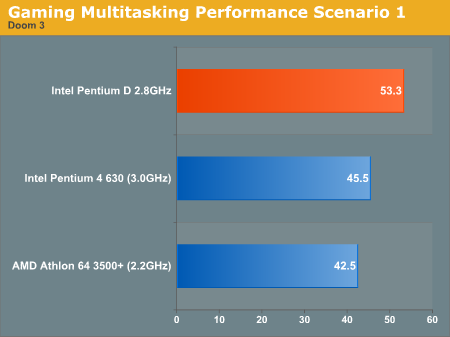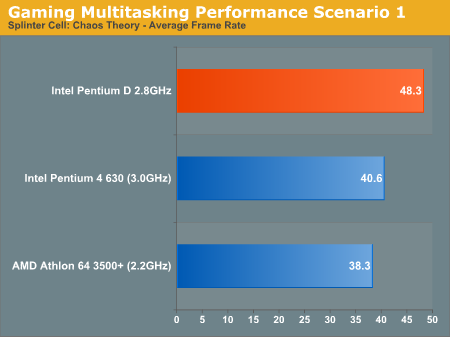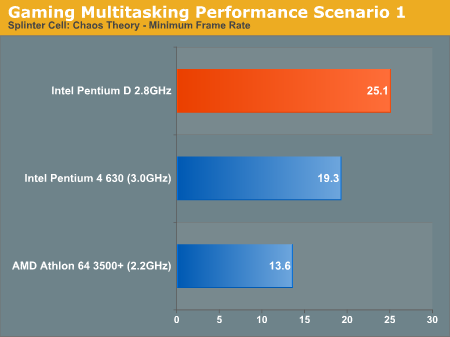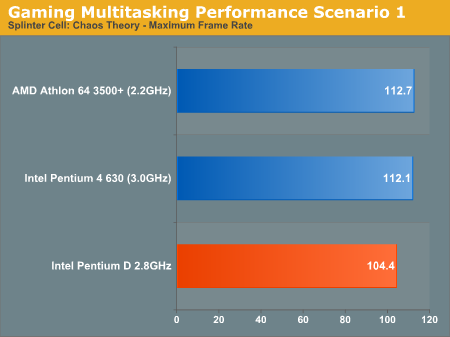Intel Dual Core Performance Preview Part II: A Deeper Look
by Anand Lal Shimpi on April 6, 2005 12:23 PM EST- Posted in
- CPUs
Gaming Multitasking Scenario 1: Heavy Downloading
In the first article, we ran under the assumption that gamers wanted to have as little running in the background while playing a game. While that ended up being true for a lot of folks, we also received quite a bit of feedback asking for some pretty intense multitasking tests while gaming. The requests were far more intense than even the most strenuous setup that we came up with, but because of the demand for such benchmarks, we spent some time putting a few together. Note that this is by no means supposed to be an exhaustive comparison of all gaming scenarios. We are working on creating more and we apologize if your desired scenario didn't make it into this review, but keep sending in suggestions on how you play and we'll do our best to model some benchmarks after how you use your computer.
The first test basically performs all of the tasks from our first Multitasking Scenario, with the exception of DVD Shrink. We have Firefox loaded, but with all 12 tabs from the third test, iTunes is running and playing a playlist, and Newsleecher is downloading headers. We kept Newsleecher in this test simply because it's the best way for us to be able to have a fairly CPU/disk intensive downloading task running in the background while still maintaining some semblance of repeatability. So, replace Newsleecher with BitTorrent or any other resource-consuming downloading that you may be doing and you're good to go.
Of course, Norton AntiVirus 2004 and Microsoft's AntiSpyware Beta were also running in the background.
First, we ran our Doom 3 benchmark:

The tables have now been turned. While the Athlon 64 held a 30% lead with no multitasking, it's now outpaced by both Intel processors, with the Pentium D holding a 25% performance advantage.
It's no surprise that having two cores yield less of a performance impact to having more applications run in the background.
Doom 3 was actually quite playable on both machines; although, loading the game and the levels took a lot longer on the A64, and there's a lot of stuttering during the actual game.
The Pentium 4 platform was quite a bit better, but there is a definite reduction in performance. Obviously, the Pentium D did the best out of the group, but you still notice the performance drop.
Next, we ran the Splinter Cell: Chaos Theory benchmark:



Once again, the Pentium D is ahead of the Athlon 64, but the improvement in minimum frame rates is particularly impressive. The Pentium D offers twice the minimum frame rate of the Athlon 64 in this scenario.










106 Comments
View All Comments
stephenbrooks - Wednesday, April 6, 2005 - link
#55 yes, that would be my best bet on what Anand was implying. AMD's 90nm process is impressive on power efficiency.bdchambers79 - Wednesday, April 6, 2005 - link
Hmm... if permormance isn't the only metric for dual-core AMD, then perhaps power also plays a role? What if they could craft a 2.2gHz monster that had the same power draw as a 2.0gHz a64? Such a beast, besides being a processing power-house, would show extreme overclock potential.cHodAXUK - Wednesday, April 6, 2005 - link
'The move down to 90nm really cut down AMD’s power consumption a lot, to the point where the 90nm Athlon 64 3500+ actually consumes less power under full load than the Pentium 4 630 at idle.'ROFL, I expect the old Prescott space heater gags to start again after this review :)
Crassus - Wednesday, April 6, 2005 - link
Hey Anand,on page 13 top diagramm it says "Thanks to DVD Shrink behaving and running with a low priority, our gameplay was largely unaffected on the Athlon 64. The performance dropped less than 3% in Doom 3. ..." yet the graph shows the A64 at the bottom far behind the Pentiums. Is the graph messed up or the comment?
Great article though and thatnk you for listening to your readers.
Thanks also for the NCQ-page. I still wonder if you want to pick up where you left off some months ago and look into RAID in more detail, possible measuring the impact of NCQ on the benefits of SMT or vice versa and CPU-load issues with simple RAID5 setups on dual-core?
Cheers, Crassus
Lonyo - Wednesday, April 6, 2005 - link
#50 and JeffLet's just say that the dual core Athlon 64 running at 2.2GHz won't be compared to a dual core Pentium D running at 2.8GHz.
AMD's dual core will be quite impressive, even more so than Intel's. Don't look at performance as the only vector to measure though...
....PRICE.
I think you were spot on. 2.2GHz DC Athlon is almost certain NOT to compare to PD2.8GHz.
The article is comparing 3 systems with the same price processor.
The comments from Anand suggest that the 2.2GHz AMD DC will blow the 2.8GHz PD away, but at a higher price.
The 1.8GHz AMD DC is more likely to be comparable (and possible faster, if the 2.2GHz Athlon really is amazing). But who knows?
coldpower27 - Wednesday, April 6, 2005 - link
Tomshardware was able to overclock the Pentium EE 3.2GHZ Dual Core to 3.8GHZ, and 4GHZ on some exotic form of cooling.coldpower27 - Wednesday, April 6, 2005 - link
Rumors indicate AMD's aiming for a launch at 1.8GHZ - 2.2GHZ frequencies for the Athlon 64 Dual Cores, I would guess, that most likely that these Dual Cores are based on the San Diego cores, as they each have access to 1MB of cache with a die surface area slightly larger then Clawhammer.Another guess would be they would use the 2.2GHZ Dual Cores as their FX flagship and have the 1.8GHZ/2.0GHZ variants as their mainstream line.
However with AMD saying 2H 2005 for their Dual Cores, we won't have to wait too long then for Intel's new version of Dual Core in 1H 2006 on the 65nm process.
Maybe the 2.2GHZ Athlon 64 Dual Core is much more expensive then the 2.8GHZ Pentium D? Or it competes with Intel's Pentium D 3.2GHZ.
defter - Wednesday, April 6, 2005 - link
Great review! It is refreshing to see different kinds of benchmarks.The problem with dual core Athlon64 is that it won't be launched until 2006 according to the AMD's roadmap: http://www.amd.com/us-en/Processors/ProductInforma... (dual core Athlon64 FX will be launched in H2 2005, but no regular dual core Athlon64 is scheduled for 2005)
And in 2006, Intel will have 65nm dual core chips available...
PrinceXizor - Wednesday, April 6, 2005 - link
For those saying that Intel will have ANOTHER dual core system out because of the delay by AMD...remember...this was a technology PREVIEW. There is no released hardware yet.Its going to be interesting to see what the benefits of AMD's built from the ground up to be multi-core approach vs. Intel's patch job (I still have utmost respect for Intel, they created one fine "patch job" under a severe time constraint, sometimes it does pay to be a behemoth ;)) will be.
P-X
NetMavrik - Wednesday, April 6, 2005 - link
Don't take this post the wrong way, I am not knocking Intel's HyperThreading, but I think most people have actually forgotten what it is. It is not a feature of the Pentium 4, but a bandaid approach to keep their now 31 stage pipeline busy doing something. The reason that a 3.8GHz P4 doesn't run circles around a 2.6GHz A64 is that horribly designed 31 stage pipeline. AMD can't implement some form of HyperThreading because it doesn't have a bunch of processor stages sitting around doing nothing like a P4 does without HyperThreading.